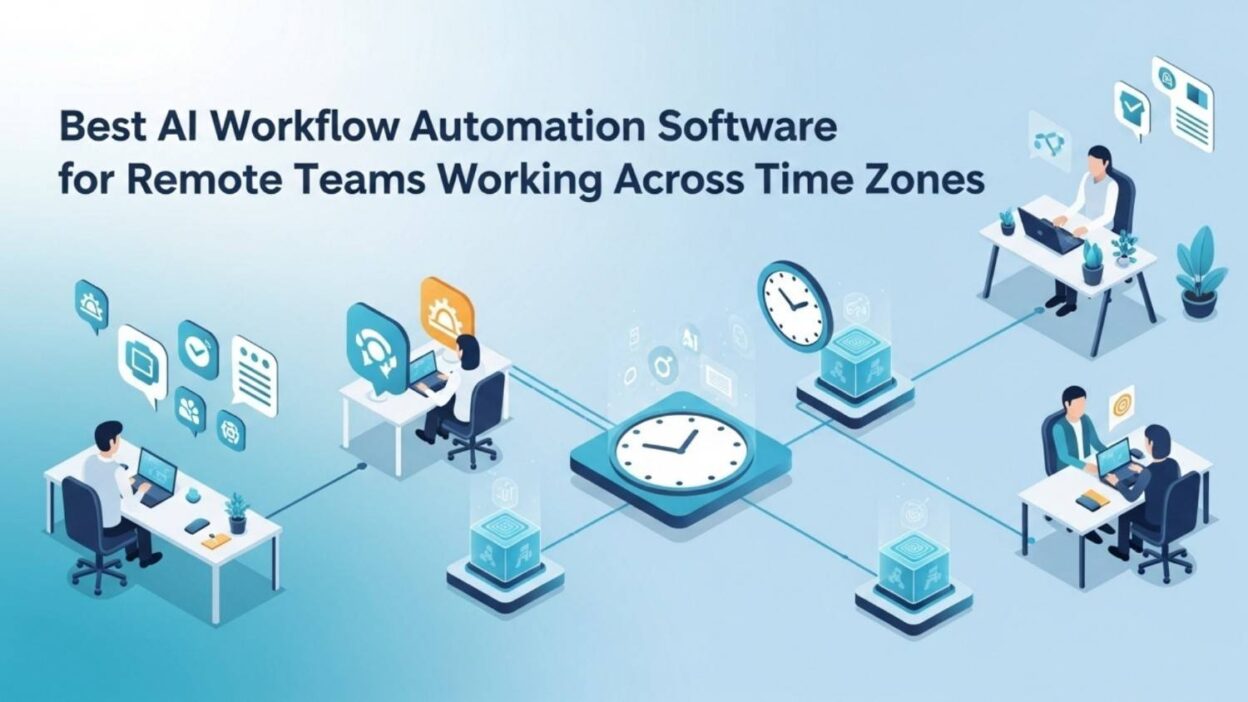Introduction
TL;DR Remote work transformed from necessity to permanent business strategy. Teams now span continents and time zones. A developer in Mumbai collaborates with a designer in San Francisco. A project manager in London coordinates with engineers in Sydney.
This geographic distribution creates unique challenges. Handoffs between time zones cause delays. Status updates arrive while you sleep. Meetings require someone to work odd hours. Work progress stalls waiting for responses across different schedules.
AI workflow automation software for remote teams solves these coordination nightmares. Smart systems keep work flowing regardless of who’s online. Tasks route automatically to available team members. Updates happen asynchronously without manual intervention. Your projects advance around the clock.
Traditional project management tools fall short for distributed teams. They require real-time coordination that different time zones make impossible. Manual handoffs create bottlenecks. Information gets lost between shifts. Productivity suffers despite talented team members.
Modern automation changes this reality completely. Intelligent systems understand team availability patterns. Work distributes based on time zones automatically. Nobody waits hours for simple approvals. Your remote team operates like a well-oiled machine.
This guide explores the best AI workflow automation software for remote teams navigating time zone complexity. You’ll discover platforms designed specifically for asynchronous collaboration. You’ll learn how smart automation maintains momentum across global operations. Your distributed team will finally work at full potential.
Table of Contents
Understanding Time Zone Challenges in Remote Team Workflows
Time zone differences create friction that slows remote teams considerably. Recognizing these challenges helps you select appropriate automation solutions.
Communication delays fragment project timelines unnecessarily. Your question sits unanswered for eight hours while teammates sleep. Simple clarifications that take minutes face-to-face require full days remotely. Projects drag on despite everyone working diligently.
Meeting scheduling becomes a mathematical nightmare. Finding overlapping work hours across New York, Berlin, and Tokyo proves nearly impossible. Someone always sacrifices sleep or family time. Meeting fatigue compounds when sessions occur at inconvenient hours.
Work handoffs create dangerous gaps. The Mumbai team finishes their day and passes work to the London team. Critical context gets lost in documentation. The London team spends hours understanding what Mumbai accomplished. Duplication and confusion waste valuable time.
Decision-making bottlenecks stall progress completely. Leaders in specific time zones become approval gatekeepers. Work piles up waiting for sign-offs. Team members in other regions sit idle despite willingness to contribute.
Documentation gaps emerge from asynchronous work patterns. People complete tasks but forget to update shared systems. The next shift lacks context about decisions and changes. Redundant work happens when information doesn’t flow properly.
Relationship building suffers without real-time interaction. Water cooler conversations don’t happen remotely. Team cohesion weakens when people never overlap. Culture development requires intentional effort that synchronous teams get naturally.
Emergency response capabilities diminish across time zones. Critical issues arising during off-hours wait for specific people. System outages persist longer than necessary. Customer problems go unaddressed for extended periods.
How AI Automation Specifically Addresses Time Zone Workflow Issues
AI workflow automation software for remote teams targets the specific pain points of distributed operations. These intelligent systems redesign workflows around asynchronous collaboration.
Smart routing eliminates waiting for specific people. AI analyzes team member locations, availability, and expertise. Work assignments consider current time zones automatically. Tasks reach available qualified people instantly. Projects progress continuously regardless of who’s online.
Automated status updates keep everyone informed without meetings. Systems compile progress reports from completed tasks automatically. Team members receive summaries when they start their workday. Nobody spends time updating spreadsheets or writing status emails.
Intelligent handoff protocols maintain context across shifts. AI captures decisions, blockers, and next steps automatically. The system presents relevant information to incoming team members. Context loss disappears when automation handles knowledge transfer.
Predictive scheduling optimizes meeting timing automatically. Systems analyze historical attendance patterns and time zones. AI suggests meeting times that minimize inconvenience. Fair distribution ensures burden rotates rather than concentrating on specific regions.
Approval workflows route around unavailable decision-makers. AI identifies alternative approvers based on organizational hierarchy. Work doesn’t stall waiting for one person. Delegation rules execute automatically when primary approvers are offline.
Documentation happens automatically through system usage. Every decision and action gets recorded in centralized platforms. AI organizes information for easy retrieval. Team members find what they need without asking colleagues.
Communication prioritization helps teams focus appropriately. AI categorizes messages by urgency and relevance. Critical items surface immediately regardless of time zones. Routine updates wait for convenient review times.
Monday.com: Visual Workflow Automation for Distributed Teams
Monday.com excels at creating transparent workflows that transcend time zones. The platform visualizes work progress in ways that eliminate confusion for distributed teams.
The visual board interface shows project status at a glance. Team members opening Monday.com immediately understand current situations. Color coding indicates bottlenecks and completed work. Nobody needs real-time updates to know project health.
Automations handle routine coordination tasks automatically. The system assigns work based on availability and expertise. Status changes trigger notifications to relevant team members. File uploads alert appropriate reviewers automatically.
Time zone awareness builds into the platform natively. Meeting scheduling tools display multiple time zones simultaneously. Deadline settings account for team member locations automatically. Nobody misses deadlines due to timezone confusion.
Integration capabilities connect Monday.com with essential tools. Slack notifications keep remote teams informed asynchronously. Email integrations send summaries to people preferring that channel. Calendar syncs ensure availability data stays current.
Custom workflows accommodate unique remote team needs. You design automation sequences matching your specific processes. No-code builders allow non-technical managers to create sophisticated workflows. Templates accelerate setup for common use cases.
Workload views prevent burnout across time zones. Managers see team capacity regardless of location. Assignments distribute fairly across all regions. Nobody drowns while others have light loads.
Pricing starts at $8 per user monthly. Enterprise plans include advanced automation and priority support. The investment pays off through eliminated coordination overhead. Remote teams reclaim hours previously spent on status updates.
Asana: Intelligent Task Management Across Global Teams
Asana provides robust task management with automation features designed for remote collaboration. The platform keeps distributed teams aligned without constant check-ins.
Universal inbox functionality centralizes communications. Every team member sees relevant updates upon logging in. Time zone differences don’t create information gaps. People catch up efficiently regardless of work hours.
Rules engine automates task progression automatically. Completed tasks trigger assignments to next responsible parties. Dependencies respect time zones and availability. Work flows smoothly from one region to another.
Timeline views visualize project schedules across locations. Managers spot bottlenecks before they impact deadlines. Resource allocation accounts for regional holidays automatically. Planning becomes globally aware rather than headquarters-centric.
Forms streamline intake processes asynchronously. Requests enter systems through standardized forms. AI routes submissions to appropriate team members automatically. Nobody waits for specific people to process requests.
Portfolio management provides leadership visibility. Executives track multiple projects across all time zones. Status reporting happens automatically through task completion. Leaders make informed decisions without meeting coordination.
Goal tracking maintains team alignment despite distance. Objectives cascade from company to individual levels. Progress visibility keeps everyone motivated. Remote workers understand how their work contributes.
Mobile applications enable participation from anywhere. Team members contribute during their productive hours. Notifications respect local time quiet hours. Work-life balance improves when systems adapt to schedules.
Free plans support teams up to 15 members. Premium tiers start at $10.99 per user monthly. AI workflow automation software for remote teams rarely offers better value. Asana delivers enterprise capabilities at accessible prices.
ClickUp: All-in-One Remote Team Productivity Platform
ClickUp combines project management, documentation, and automation in one comprehensive platform. Remote teams eliminate tool-switching that wastes time across time zones.
Everything view aggregates work from all projects. Team members see their responsibilities regardless of project or department. This consolidation prevents things from falling through cracks. Distributed teams maintain awareness effortlessly.
Custom statuses reflect your actual workflow stages. Remote teams define processes matching their operations. Automation triggers based on these custom states. Work progresses according to your unique needs.
Assigned comments ensure accountability asynchronously. Questions tag specific people automatically. The system tracks comment resolution independently. Follow-ups happen without meetings or reminder messages.
Recording capabilities document decisions thoroughly. Screen recordings explain complex concepts better than text. Team members consume these recordings during their hours. Knowledge transfer happens effectively across time zones.
Time tracking integrates natively without additional tools. Teams log hours within the same platform they manage tasks. Reports aggregate data across all time zones. Billing and productivity analysis become straightforward.
Mind maps facilitate planning sessions asynchronously. Teams brainstorm and organize ideas visually. Contributors add thoughts during their work hours. Collective intelligence emerges without synchronous meetings.
Workload management prevents imbalanced assignments. The system visualizes team capacity across locations. Managers distribute work fairly considering time zones. Burnout risks decrease through intelligent allocation.
Free forever plans include substantial functionality. Unlimited paid plans cost $7 per user monthly. ClickUp delivers exceptional value for remote team needs. The platform eliminates purchasing multiple specialized tools.
Notion: Collaborative Knowledge Base with Workflow Automation
Notion creates unified workspaces where remote teams document and execute work simultaneously. The platform bridges documentation and task management seamlessly.
Wiki functionality centralizes team knowledge permanently. Information lives in searchable databases accessible anytime. New team members onboard without timezone-dependent training. Documentation becomes the single source of truth.
Database views display information multiple ways. Team members customize views matching their preferences. One database serves multiple purposes across departments. Information management becomes flexible yet organized.
Templates standardize processes across global teams. Meeting notes, project briefs, and task lists follow consistent formats. Quality remains high regardless of who creates content. Remote teams work more cohesively through standardization.
Inline comments enable asynchronous discussions. People ask questions directly within documents. Context remains attached to specific content. Conversations don’t get lost in email threads.
Version history tracks document evolution automatically. Teams see who changed what and when. Mistakes revert easily without data loss. Accountability increases through transparent change tracking.
Automation connects Notion with external tools. Zapier integrations sync data between platforms. Tasks created in Notion appear in calendars automatically. Information flows between systems without manual intervention.
Real-time collaboration allows simultaneous editing. Multiple people contribute to documents concurrently. Changes appear instantly for everyone online. Asynchronous and synchronous work blend naturally.
Personal plans remain free indefinitely. Team plans start at $8 per user monthly. AI workflow automation software for remote teams finds strong competition in Notion. The platform excels at knowledge work automation.
Slack with Workflow Builder: Communication Automation for Async Teams
Slack revolutionized team communication and now offers robust automation for remote workflows. The platform keeps distributed teams connected without requiring simultaneous availability.
Workflow Builder creates custom automation without coding. Teams design processes using visual interfaces. Form submissions trigger actions automatically. Repetitive communication tasks disappear.
Scheduled messages respect time zone boundaries. Important announcements reach people during work hours. Nobody receives notifications while sleeping. Communication becomes considerate of global schedules.
Huddles provide lightweight synchronous options. Team members jump into audio conversations spontaneously. No scheduling required for quick clarifications. Asynchronous communication gets supplemented appropriately.
Channel organization prevents information overload. Topic-specific channels keep discussions focused. Team members subscribe to relevant conversations only. Information discovery improves through logical structure.
Search functionality makes historical information accessible. Decisions and discussions remain findable indefinitely. New team members search past conversations. Institutional knowledge persists beyond individual memories.
Integration ecosystem connects thousands of tools. Work updates from other platforms appear in Slack. Team members stay informed without checking multiple systems. Notifications centralize in one location.
Status features communicate availability clearly. Team members indicate working hours and focus time. Automatic away messages prevent expectation mismatches. Boundaries get respected through transparent communication.
Free plans support small teams indefinitely. Pro plans cost $7.25 per user monthly. Slack forms the communication backbone for remote teams globally. The platform becomes indispensable for distributed operations.
Zapier: No-Code Automation Connecting Remote Team Tools
Zapier connects disparate tools through automated workflows. Remote teams orchestrate complex processes without technical expertise.
Zaps create automated workflows between applications. Triggers in one tool cause actions in another. Data syncs across platforms automatically. Manual data entry disappears completely.
Multi-step zaps handle sophisticated processes. Complex workflows execute through simple trigger events. Remote teams automate entire process chains. Work progresses through systems without human intervention.
Filters add conditional logic to workflows. Automations execute only when specific criteria match. Intelligent routing happens based on content or timing. Workflows become context-aware and adaptive.
Schedule triggers initiate time-based automations. Reports generate automatically at specified times. Reminders send appropriate to recipient time zones. Routine tasks happen reliably without manual initiation.
Paths create branching workflow logic. Different conditions trigger different action sequences. Complex business rules execute automatically. Decision-making happens systematically without human bottlenecks.
App directory includes 5000+ integrations. Remote teams connect virtually any combination of tools. Custom workflows accommodate unique technology stacks. Platform limitations disappear through universal connectivity.
Transfer tool migrates data between applications. Historical information moves to new systems automatically. Remote teams upgrade tools without losing data. Platform transitions happen smoothly.
Free plans include 100 tasks monthly. Starter plans begin at $19.99 monthly. AI workflow automation software for remote teams relies heavily on Zapier. The platform enables sophisticated automation economically.
Airtable: Flexible Database Automation for Remote Operations
Airtable combines spreadsheet simplicity with database power. Remote teams manage complex information with automated workflows.
Customizable views display data appropriately for different roles. Sales teams see pipeline views while developers see Kanban boards. One database serves multiple team needs simultaneously. Information management becomes flexible yet unified.
Linked records connect related information automatically. Projects link to clients, tasks, and team members. Relationships maintain automatically as data changes. Information integrity remains high across remote teams.
Automations trigger based on data changes. Status updates send notifications to relevant people. Record creation initiates approval workflows. Business rules execute consistently without manual enforcement.
Forms collect information into structured databases. External stakeholders submit requests through branded forms. Data enters systems in consistent formats. Remote teams eliminate data cleaning work.
Sync features connect Airtable with external systems. Data flows between tools bidirectionally. Changes in one location propagate automatically. Information remains current across platforms.
Interface designer creates custom applications. No-code tools build sophisticated user experiences. Remote teams develop tailored solutions for specific needs. Technical barriers to customization disappear.
Collaboration features enable team contribution. Comments, mentions, and real-time editing keep teams aligned. Permissions control access appropriately. Security and transparency balance properly.
Free plans support unlimited bases with limitations. Plus plans start at $10 per user monthly. Airtable excels for remote teams managing structured information. The platform bridges spreadsheets and sophisticated databases.
Trello with Butler: Visual Workflow Automation Made Simple
Trello provides intuitive visual organization with powerful automation capabilities. Remote teams manage work through simple card movements.
Board structure visualizes workflow stages clearly. Cards move between lists representing progress. Team members understand status instantly without explanations. Visual management transcends language and timezone barriers.
Butler automation creates sophisticated workflows. Card movements trigger actions automatically. Due dates adjust based on time zones. Routine coordination happens without human intervention.
Calendar power-up displays deadlines chronologically. Teams see upcoming work across all boards. Timeline views show project sequences. Planning becomes comprehensive and coordinated.
Custom fields add structured data to cards. Teams track information relevant to their work. Filtering and sorting leverage this additional data. Information management becomes more sophisticated.
Workspace views aggregate cards across boards. Team members see all assigned work regardless of project. Nothing falls through cracks when visibility spans everything. Remote workers maintain comprehensive awareness.
Templates standardize processes across teams. Recurring projects copy complete board structures. Consistency improves through reusable frameworks. Remote teams work more cohesively through standards.
Communication happens directly within cards. Comments keep discussions attached to relevant work. Mentions notify specific people asynchronously. Context remains connected to tasks permanently.
Free plans include unlimited cards and members. Standard plans cost $5 per user monthly. Trello offers exceptional value for visual thinkers. The platform’s simplicity enables rapid remote team adoption.
Building Your Remote Team Automation Strategy
Successful automation requires thoughtful planning. AI workflow automation software for remote teams delivers value only when implemented strategically.
Audit current processes before selecting tools. Map how work flows between team members currently. Identify handoff points causing delays. Document time zone friction points specifically. This analysis guides tool selection appropriately.
Involve team members across all time zones. People in different regions face unique challenges. Their input ensures automation addresses actual needs. Buy-in increases when teams shape solutions collaboratively.
Prioritize automation opportunities by impact. Focus on bottlenecks affecting multiple people daily. Quick wins build momentum and demonstrate value. Complex automations can wait until foundational systems stabilize.
Choose platforms with strong integration capabilities. Remote teams use multiple specialized tools. Automation value multiplies when systems connect seamlessly. Isolated tools limit potential benefits dramatically.
Start with pilot programs before full deployment. Test automation with one team or project initially. Learn from early implementation before expanding. Mistakes cost less when contained to pilot scope.
Document automation workflows thoroughly. Team members need to understand how systems work. Documentation enables troubleshooting without waiting for specific people. Knowledge should distribute across time zones.
Train teams on new systems asynchronously. Record training videos people watch during their hours. Create written guides for reference. Live training excludes team members in different zones.
Measure automation impact systematically. Track time saved and bottlenecks eliminated. Survey team satisfaction regularly. Data proves value and guides future improvements.
Integrating AI Automation with Existing Remote Work Tools
New automation should enhance rather than replace current systems. AI workflow automation software for remote teams works best integrated thoughtfully.
Evaluate your current tool stack comprehensively. List every platform your team uses regularly. Understand the purpose each tool serves. Identify overlap and gaps in functionality.
Research integration capabilities thoroughly. Check native integrations between platforms first. Examine third-party connection options through Zapier or similar tools. API availability enables custom integrations when necessary.
Map data flows between systems carefully. Understand which information needs synchronization. Define single sources of truth for different data types. Prevent conflicts when information exists in multiple places.
Start with high-value integrations first. Connect tools that create significant manual work currently. Time tracking integrated with project management eliminates double entry. Calendar sync prevents scheduling conflicts automatically.
Test integrations extensively before full deployment. Verify data accuracy and synchronization speed. Ensure error handling works appropriately. Small test data sets prevent major problems.
Create fallback procedures for integration failures. Systems occasionally disconnect or malfunction. Teams need manual processes for continuation. Documentation enables recovery without specific people.
Monitor integration health continuously. Set up alerts for synchronization failures. Review error logs regularly. Proactive maintenance prevents disruptions.
Optimize integrations based on usage patterns. Remove connections providing minimal value. Strengthen workflows generating significant efficiency. Integration complexity should match actual benefits.
Measuring Success: KPIs for Remote Team Automation
Quantifying automation impact proves value and guides improvements. Track metrics that matter for distributed operations.
Time-to-completion metrics show efficiency gains. Measure how long tasks take from creation to completion. Compare before and after automation implementation. Improvements demonstrate automation value clearly.
Handoff delays reveal coordination improvements. Track time elapsed during transitions between time zones. Reduced delays prove automation smooths workflows. Target should approach near-zero delays.
Meeting frequency indicates asynchronous effectiveness. Count meetings per week before and after automation. Decreasing meeting needs demonstrates better asynchronous coordination. Time reclaimed becomes available for productive work.
Team satisfaction scores measure human impact. Survey team members about work experience regularly. Satisfaction improvements prove automation supports wellbeing. Declining scores indicate problems needing attention.
Decision latency shows leadership effectiveness. Measure time between questions and decisions. Faster decisions demonstrate approval automation works. Bottlenecks become visible through this metric.
Documentation quality affects knowledge transfer. Audit documentation completeness periodically. Improved documentation indicates better information capture. Knowledge loss decreases across time zones.
Response time distributions reveal communication health. Track how long team members take responding. Distributions should reflect actual time zones rather than waiting periods. Improvements prove asynchronous systems work.
Project completion rates demonstrate overall effectiveness. Track percentage of projects finishing on schedule. Rates improving prove coordination strengthens. Remote teams should match or exceed collocated performance.
Security Considerations for Remote Team Automation
Security grows more complex with distributed teams and automation. Protect data without hindering productivity.
Access controls must reflect team distribution. People need appropriate access during their time zones. Overly restrictive permissions create bottlenecks. Balance security with workflow requirements.
Authentication requirements should enable rather than block. Multi-factor authentication protects accounts without excessive friction. Biometric options work well for mobile team members. Security measures should feel reasonable.
Data residency regulations affect international teams. Understand where customer data can reside legally. Choose automation platforms with appropriate data centers. Compliance violations create serious consequences.
Encryption protects data in transit and at rest. Verify automation platforms use current security standards. API connections should require encrypted communication. Security shouldn’t rely solely on perimeter defenses.
Audit trails track actions across time zones. Comprehensive logging enables security investigations. Unusual patterns become detectable through monitoring. Accountability increases when actions trace to individuals.
Permission reviews should happen regularly. People change roles and leave organizations. Automation can maintain current permissions automatically. Stale access creates security vulnerabilities.
Vendor security assessments protect your data. Research automation platform security practices thoroughly. Look for certifications like SOC 2 and ISO 27001. Your security depends on vendor security.
Incident response plans account for time zone distribution. Security issues need addressing regardless of hour. Define escalation procedures spanning all regions. Practice response procedures periodically.
Overcoming Common Remote Automation Implementation Challenges
Every remote team faces obstacles implementing automation. Awareness enables preparation and problem-solving.
Resistance emerges from fear and uncertainty. People worry automation eliminates jobs or monitors excessively. Address concerns through transparent communication. Frame automation as enabling better work rather than replacing people.
Technical complexity intimidates non-technical teams. Choose platforms with intuitive interfaces. Provide thorough training and ongoing support. Celebrate early successes to build confidence.
Integration difficulties frustrate implementation efforts. Legacy systems may lack modern APIs. Budget for custom development when necessary. Sometimes manual bridging temporarily fills gaps.
Change fatigue affects teams facing constant evolution. Remote work itself represents significant change. Space automation rollouts appropriately. Recognize when teams need stability.
Time zone coordination makes training challenging. Record comprehensive training materials for asynchronous learning. Offer multiple live sessions spanning different regions. Written documentation supports all learning styles.
Budget limitations restrict tool selection. Start with free tiers and basic plans. Prove value before requesting expanded budgets. Many platforms offer nonprofit or startup pricing.
Cultural differences affect adoption patterns. Teams in different regions may embrace or resist technology differently. Customize change management for regional preferences. Respect diverse working styles.
Measurement challenges obscure automation value. Define success metrics before implementation. Baseline current performance for comparison. Quantitative proof convinces skeptics effectively.
Future Trends in Remote Team Workflow Automation
AI workflow automation software for remote teams continues evolving rapidly. Understanding trends helps you prepare for changes.
Predictive automation anticipates needs proactively. Systems learn patterns and suggest actions before requests. Meeting scheduling happens automatically based on past behavior. Automation becomes invisible and intuitive.
Natural language processing eliminates interface complexity. Team members interact with automation through conversation. Commands execute through chat rather than complex configurations. Technical barriers disappear completely.
Autonomous agents handle entire workflows independently. AI completes multi-step processes without human guidance. Teams delegate work to virtual assistants confidently. Human involvement decreases for routine workflows.
Augmented reality enables richer remote collaboration. Virtual workspaces simulate physical presence. Documentation becomes spatial and immersive. Distance feels less significant through enhanced experiences.
Blockchain technology enables trustless automation. Smart contracts execute agreements without intermediaries. International teams collaborate without currency friction. Trust builds through technology rather than relationships alone.
Emotional intelligence capabilities improve team dynamics. AI detects stress and burnout through communication patterns. Systems recommend interventions protecting wellbeing. Technology supports human health proactively.
Quantum computing accelerates complex optimizations. Schedule coordination becomes infinitely more sophisticated. Resource allocation considers countless variables simultaneously. Computational limits disappear for workflow optimization.
Neuromorphic systems learn continuously like humans. Automation adapts to changing conditions automatically. Manual reconfiguration becomes unnecessary. Systems improve themselves over time.
Frequently Asked Questions About Remote Team Workflow Automation
How much technical expertise do remote teams need for workflow automation?
Modern platforms require no coding knowledge. Visual interfaces guide workflow creation intuitively. Most remote team leaders implement basic automation independently. Complex scenarios might need help from affordable specialists.
Can automation completely eliminate time zone coordination challenges?
Automation dramatically reduces friction but cannot eliminate it entirely. Some decisions require real-time collaboration. The goal involves minimizing synchronous needs. Well-automated teams coordinate 80% asynchronously.
What’s the minimum team size benefiting from workflow automation?
Even two-person remote teams benefit from basic automation. Value scales with team size and distribution. Solo entrepreneurs gain from automation reducing repetitive work. No team is too small for appropriate automation.
How long does implementing workflow automation take?
Basic automation deploys within days or weeks. Comprehensive transformation requires 3-6 months. Timeline depends on process complexity and existing systems. Gradual implementation works better than massive changes.
Will automation make remote teams feel less connected?
Poorly implemented automation can reduce human connection. Thoughtful deployment actually improves relationships. Teams spend reclaimed time on meaningful interaction. Automation handles logistics while people focus on people.
How do we choose between competing automation platforms?
Evaluate integration with existing tools first. Consider team technical comfort levels honestly. Test platforms through free trials extensively. Involve team members in selection processes. Decision should reflect actual needs not marketing promises.
What happens when automated workflows fail?
Build fallback procedures for critical processes. Systems should alert people to automation failures. Manual processes bridge gaps during outages. Redundancy prevents single points of failure.
How do we measure return on investment for automation?
Track time saved through automation implementation. Calculate hourly costs of reclaimed time. Monitor project completion improvements. Survey team satisfaction regularly. ROI becomes clear through comprehensive measurement.
Read More:-Harnessing Process Mining and AI Analytics for Data-Driven Decision-Making
Conclusion

Remote teams working across time zones face unique coordination challenges. Traditional management approaches fail when teams never work simultaneously. Manual handoffs create bottlenecks that stall progress unnecessarily.
AI workflow automation software for remote teams provides proven solutions for these problems. Smart systems keep work flowing regardless of who’s online. Tasks route to available team members automatically. Documentation happens without manual effort.
The platforms explored here offer different strengths for various needs. Monday.com excels at visual workflow management. Asana provides comprehensive task tracking capabilities. ClickUp combines multiple tools into unified platforms. Notion creates knowledge bases with automation. Each solution addresses specific remote team needs.
Implementation success requires strategic thinking and team involvement. Audit your current processes thoroughly. Involve team members across all time zones. Start with high-impact automations first. Measure results systematically and iterate based on feedback.
Security and integration deserve careful attention. Distributed teams create complex security requirements. Systems must connect seamlessly for maximum value. Technical decisions impact daily operations significantly.
The future of remote work depends heavily on intelligent automation. Teams adopting these technologies gain competitive advantages. Your distributed workforce can outperform collocated competitors. Geography becomes irrelevant when automation eliminates friction.
Start your automation journey today by selecting one platform that addresses your biggest pain point. Implement thoughtfully with team input. Measure impact rigorously. Your remote team deserves tools matching their distributed reality.
AI workflow automation software for remote teams transforms distance from limitation into advantage. Your global talent pool works seamlessly when technology enables coordination. The investment in automation returns value many times over through improved productivity and satisfaction.
Take action now to unlock your remote team’s full potential. The technology exists and proves effective daily. Your competition already automates. Your team deserves these capabilities immediately.





